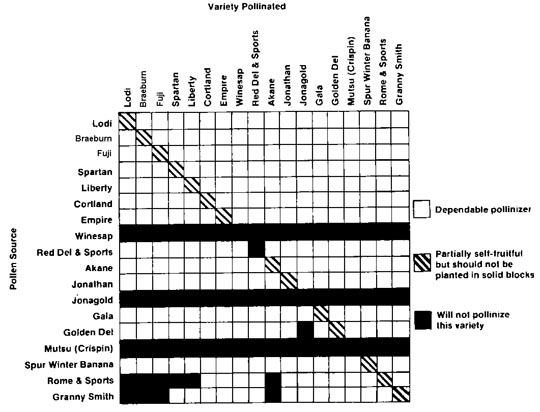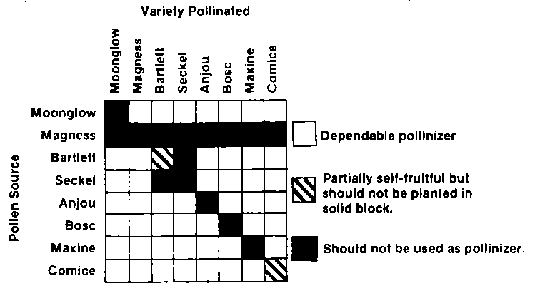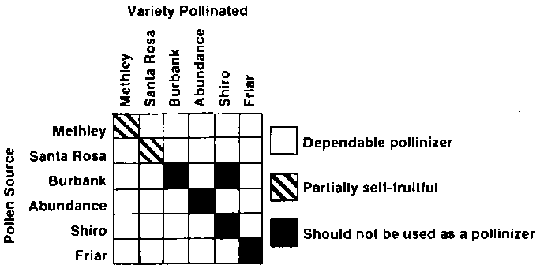by A. Gaus and H. Larsen1 (10/09)
Quick Facts…
- Before purchasing trees, evaluate the pollination requirement of the given fruit crop.
- Place pole-type pollinators every 60 to 120 feet in every row, with adjacent rows offset.
- The honey bee is the most important carrier of pollen.
- All varieties of apples require some cross-pollination.
- All sour cherries are self-fruitful. All sweet cherry varieties, except Stella, are self-unfruitful and must be cross-pollinated.
- Common varieties of nectarines and most peaches grown in Colorado are self-fruitful.
Most fruit trees need cross-pollination for good fruit set, and you may need to buy more than just one variety.

Many new plantings, especially apple orchards, are planted in a solid block of one variety to make more efficient use of land, labor and cultural practices (thinning, pruning, chemical sprays, harvesting). For pollination, place pole-type pollinators every 60 to 120 feet in every row, with adjacent rows offset. These pollinizer trees, trained as a pole-type or slender spindle, take up little or no productive space in the orchard but give maximum fruit set potential. For backyard trees, a pollen source, such as a neighbor’s crabapple tree, should be no more than 100 feet away.
In established orchards without adequate pollinizers, the top of every third tree in every third row may be grafted to a pollinizing variety. In backyard situations, you may want to graft a pollinizing variety on one of the scaffold limbs. Bouquets also may be used by placing branches of open, fresh blossoms of a pollinating variety in buckets of water and hanging them in the trees.
The honeybee is the most important carrier of pollen. In mature orchards, there should be a minimum of one hive per acre (two hives per acre in pear orchards). Pollen transfer is seldom done by wind. Backyard plantings probably have enough wild bees to do the job.
Some orchard cover Crops, such as dandelion blooms, are very attractive to bees. Remove the blooms by mowing or herbicide sprays to increase pollination for apples. Bees are not active in cool, wet or windy weather. More bee colonies may be needed in such weather.
Apple
All varieties of apple trees require some cross-pollination for fruit set. Even though some varieties are listed as self-fruitful, they will set fruit more heavily and more regularly if they are cross-pollinated. For solid block plantings, spur-type Winter Banana, spur-type Golden Delicious, or flowering crabapples such as Manchurian and Snodrift may be used for pollinizers.
Place honeybees in apple orchards when the first blossoms open.

Figure 1: Pollination of apples. |
Peach, Nectarine and Apricot
The common varieties of nectarines and most peaches grown in Colorado are self-fruitful. Self-unfruitful varieties of peaches are J.H. Hale, Earlihale, Hal-Berta, Candoka and Mikado (June Elberta). Most other varieties of peaches will pollinate these self-unfruitful varieties. However, Elberta is not a good pollinizer for J.H. Hale. Self-fruitful varieties of apricots are Tilton, Wenatchee, Royal and Moorpark. These will set commercial Crops without cross-pollination. Self-unfruitful varieties of apricots are Riland, Perfection and Rival. Any self-unfruitful varieties can be pollinized by any other variety.
Sour and Sweet Cherry
All sour cherries are self-fruitful, such as Montmorency, North Star, Balaton, Meteor, English Morello, Early Richmond, Hansen Bush Cherry and Nanking. Most sweet cherries are self-unfruitful(self-incompatible, SI) and require cross pollination with another variety as the pollen source.
Some varieties, e.g. Bing, Lambert, Royal Ann/Napoleon, are also cross-unfruitful and cannot be depended upon to provide pollen for each other. Index, Lapins, Skeena, Sweetheart, WhiteGold, Sonata, Stella, Symphony, Sunburst, and BlackGold are self-fruitful (SF) sweet cherries that can serve as “universal” pollen sources for many self-unfruitful sweet cherry varieties (Stella does not work for Bing in some areas).
Their use as “universal” pollinators should also take bloom timing into consideration as follows. Early-bloom: SI – Somerset; SF – Lapins and Skeena. Early- to early-mid-bloom: SI – Kristin, Chelan, and Black Republican; SF – Sweetheart and WhiteGold. Mid- to late-mid-bloom: SI – Royalton, Summit, Ranier, Royal Ann / Napoleon, Bing, Burlat, Van, Regina, Lambert, Sam, and Windsor; SF – Sonata, Stella, Symphony, and Sunburst. Late-bloom: SI – Gold and Hudson; SF – BlackGold. Move bees into orchards on the first day of bloom.
Pear
Anjou and Bartlett are partially self-fruitful but should be cross-pollinated to produce heavy and regular Crops. Bartlett, Comice and Hardy may set large Crops of parthenocarpic fruit. Another consideration is the fire blight susceptibility of the pear cultivar, because the pollen source is useless if stunted or killed. (See fact sheet 2.907, Fire Blight.) Pear blossoms have a short season and the small amount of nectar produced is not attractive to bees. Twice as many bees should be available to pears than for other fruits. Move bees into the pear orchard when the trees are in one-third bloom.

Figure 2: Pollination of pears. |
Plum
Two of the most popular varieties of Japanese plum, Burbank and Abundance, are self-unfruitful but will pollinize each other. Because of bloom date differences, do not rely on European varieties to pollinize Japanese varieties.
Stanley and Damson are self-fruitful and will pollinize other European varieties. All other European plums require pollen from another European variety.

Figure 3: Pollination of Japanese plums. |
Definitions
- Pollination: the transfer of pollen from the anthers to the stigma of a flower.
- Self-pollination: when the transfer of pollen occurs within the same variety.
- Cross-pollination: when the transfer of pollen occurs between two varieties.
- Self-unfruitful: very little fruit will set unless the blossoms are fertilized with pollen of another variety.
- Self-fruitful: varieties that set fruit with their own pollen.
- Cross-unfruitful: two varieties that, when cross-pollinated, will not set fruit.
- Compatible: varieties that fertilize each other.
- Parthenocarpic: fruit that is set and grown without fertilization (no seeds present).
1A. Gaus, Colorado State University Extension fruit specialist, Rogers Mesa Research Center, Hotchkiss.4/96. Reviewed by H. Larsen, Colorado State University Extension fruit pathologist and professor; horticulture and landscape architecture, Orchard Mesa Research Center, Grand Junction. Reviewed 10/09.
Go to top of this page.





